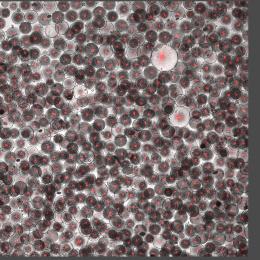Delivering Nanoparticle Treatments Through Skin
Delivering Nanoparticle Treatments Through Skin
Submitted by Jennifer Seto of the Blankschtein Laboratory in the Department of Chemical Engineering and the Langer Laboratory at the Koch Institute
Koch Institute at MIT, MIT Department of Chemical Engineering
Jennifer Seto
Blankschtein Laboratory, Department of Chemical Engineering and Langer Laboratory, Koch Institute for Integrative Cancer Research
Confocal Micrograph
"Nanoparticles have potential as transdermal drug carriers. Compared to traditional topical formulation strategies, drug-loaded nanoparticles offer advantages which include protection of unstable active agents against degradation and prolonged release of active agents. However, the penetration of nanoparticles into the skin is significantly inhibited by the skin’s inherent barrier properties. We applied ultrasound and the surfactant sodium lauryl sulfate (US/SLS) to skin (an FDA-approved method for enhancing skin permeability) to enhance the penetration of nanoparticles into skin, thereby enhancing their potential to serve as transdermal drug carriers. Left: surface of untreated skin after nanoparticle application. Right: surface of US/SLS-treated skin after nanoparticle application."






